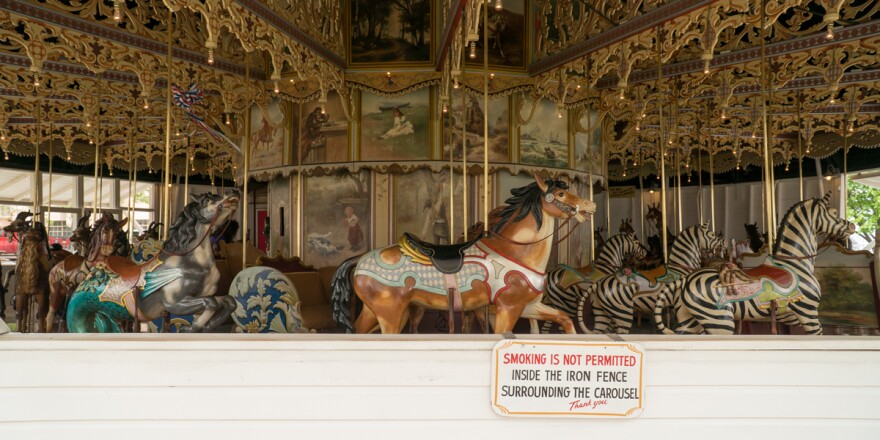At 109-years old, it is the only of its kind in the country; still, few outside of those living in this rural county seat have heard of Philadelphia Toboggan Company Carousel No. 6.
It’s simply called “the carousel” by most Burlington, Colorado residents.
“It’s Wonderful!” said Peggy Hanson, a 73-year-old Littleton, Colorado native who, along with her husband Sid, discovered PTC No. 6 by way of a chance comment at the local VFW post. “What a treasure right here in this small town.”
Despite monthly road trips through the city of 4,300 residents, it’s Hanson’s first visit to the national historic landmark. But it is far from the only time PTC No. 6 has been disregarded.

The whirling wonder was cast-off by its original owner, decried as an extravagance in its adopted community, used as a grain silo, and narrowly averted intentional incineration.
It is among 150 of the nearly 4,000 carousels built between 1885 and the 1930s that has survived intact. But it distinguishes itself from that group as the oldest carousel menagerie with its original paint still in operation.
More than a century ago, PTC No. 6, with its cadre of saddled animals and a 12mph revolution rate, was a state-of-the-art attraction commissioned for the then named Elitch Zoological Gardens in Denver.
“…The beautiful mechanism which the public will view for the first time today will show how careful she [Mary Elitch Long] was to select the best for the children,” read a May 28, 1905 article in The Rocky Mountain News.
No two of the carousel’s stationary animals and four chariots, are alike. In addition to the customary horses that adorn the decks of its contemporaries, PTC No. 6’s saddled beasts include a St. Bernard, tiger, and goat. Each and every mountable element boasts additional adornments - peculiar hand carved and painted flourishes like a snake, mouse, sheik and cherub.
The unique trimmings that set it apart were also its ticket out of town. In 1928, cowboys were in. Cowboys ride horses - not goats, or St. Bernards, or tigers.

Unconcerned with that detail, Kit Carson County Commissioners were happy to pay the carousel’s way from the big city. Although the decision did not enthuse many Depression-era residents there who viewed the $1,200 purchase as wasteful.
It wasn’t long before the carousel’s 12-sided building was shuttered.
For seven years it served as a grain silo. Damaged by rodents, some community members called for the carousel to be burned; a vast contrast to 46 years later when four stolen animals would be feted in a homecoming parade.
PTC No. 6, rejected and then scorned, was eventually embraced in a burst of American Bicentennial pride. The Kit Carson County Carousel Association was formed and has since directed its restoration and kept its storied history alive.
“Really this is a kinetic museum. It’s not an amusement park ride,” PTC No. 6 Supervisor Robbie Fearon. “It’s a museum and with museums you learn the history.”
Pat Farish has long been aware of this antique carousel and all its finery. Visiting the monument of the past was a longtime dream realized for the 73-year-old Colorado Springs native.
“The artistry, the history, the preservation, this is magnificent,” said Farish. “Every healthy adult should have an inner child within them. And my inner child is five.”

With wooden token in hand, Farish stood in line near a half-dozen actual children. All were eager to exchange its 25 cent value for five minutes of flurry-in-place. The urgent matter discussed by both young and old – which animal to ride.
17-year-old Burlington resident Trisha Reeder grew-up fighting to ride the dog on PTC No. 6. Now, as a carousel operator, her brief history of the amusement and safety instructions were all that stood between riders and anticipated bliss.
“You can use the stirrups if you want. Just don’t kick. I promise the animals aren’t going to go any faster,” Reeder joked.
Much has changed since the carousel made its first revolutions in Kit Carson County 86 years ago. But Robbie Fearon said PTC No. 6 is a reminder of the region’s rural heritage.
“To me it is a symbol of who we are,” Fearon said. “Just like this part of the country, it's been through lots of hardships. It has survived the great Dust Bowl and the Great Depression and was unappreciated and now is just a treasure.”
Like any loot worth its metal, or in this instance wood, it takes a bit of effort to find.
Explore the map and help us find more of the lost, forgotten or the little-known in the Centennial State. Have an idea? Send us a tip for Hidden Colorado.











